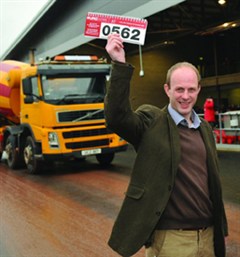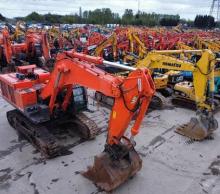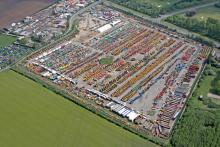
A leading used construction equipment auctioneer firm boss believes equipment aged between 2 and 4 years is now topping buyers’ ‘wish lists’, as 1 to 2-year-old used stocks deplete.
Jonnie Keys, General Manager of
“Euro Auctions has repeatedly seen over 30% of all plant sold leaving the UK and Europe for projects in Australia, South Africa, South America, Central America and India,” said Keys. “With the UK still looking for large construction or infrastructure projects to commence in the wake of the Olympics, or house building to change up a gear, the future for the used market is overseas.”
Keys said that UK prices of good second-hand equipment held through Q1 2012, and look set to hold in Q2. In 2011, 12 to 24 month old equipment was reaching premium prices, closely followed by good 24 to 48 month old stock.
“High in demand is mining and extraction equipment with large dump trucks at the top of the list and anything approaching 300 hours on the clock seen as just ‘run in’, so many owners are sitting tight as projects end, seeing values rise as demand increases,” added Keys. “Emerging markets are always the first to be seen at auction and India is a regular new participant with an appetite for small to medium sized construction machines such as backhoes, dumpers, mixers, dozers and excavators.”
According to Keys, European demand for new and second-hand machines and equipment had been affected by strengthening Sterling, leaving the UK more expensive than the rest of Europe. In Q1 of 2012, Australia continued its huge demand for new and used crushers, screeners, large dump trucks such as the
Meanwhile, with peace in North Africa continuing, second hand wheel loaders, generators, backhoes dumpers and mixing plants are in demand.
“It was apparent that much equipment was being shipped through Africa bound for destinations such as India, South America and also Australia,” said Keys. “Due to world demand companies like
Keys said that in Q1 2012 it was “still evident” that Europe has its problems to solve and economies were faltering.
He continued: “Ireland is still in the doldrums, Italy has slowed right down, with Greece and Spain feeling a lot of pain. The demand for (new and old) equipment in Europe rallied through 2011, however, in 2012 according to Off-Highway Research the next 12 months will be flat and could see plant sales drop by 2% across Europe and a further 2% in 2013. At market, Germany is the largest buyer of construction equipment in Western Europe and during the last 24 months increased acquisition by approximately 70% over 2009.”
Increased construction output in Eastern Europe is being led by Poland, said Keys, with a 34% increase on output over the previous year, whilst Romania shows 15% and Sweden 7% growth. The figures are reflected by the activity in the market, explained Keys. Decline is led by Slovenia -20%, Portugal -12% and Spain -11.5%.
Keys said: “Overall while Europe has seen a collective 1.4% decline, over 50% of used equipment is leaving the Eurozone for emerging regions. For those who are buying, the most sought after machinery categories across Europe are mini excavators, crawler excavators and telehandlers.”
Turning his attention to the Pacific Rim, Keys said Australia was where the majority of the world’s surplus mining and heavy extraction equipment had been going in more recent times.
“In the last three months demand from ‘down under’ has not wavered and the exchange rate between the Australian Dollar and Pound Sterling is still making transactions from the Northern to the Southern hemisphere extremely attractive,” said Keys. “In addition large pipeline projects, as well as the ongoing infrastructure works, are creating demands for specialised equipment with pipe welding equipment and trenching machines in high demand.
“The Australian ‘cash cow’ is still mining, with contractors, operators and dealers seeking good quality low hours equipment. Q1 was strong in this region with Volvo, Komatsu, CAT and JCB being the preferred makes. In the last three months, New Zealand emerged as a new contender having new found demand for general contracting machinery following the lead from Australia and favouring the same brands.
Keys described Asia as “fast becoming a powerhouse” in the global economy. Following a positive start to 2012, India is set to become the next newly emerging market.
“The next five years India will invest US$1.2trillion in infrastructure projects, including transport, irrigation, oil, gas and telecommunications, which will need equipment and machinery. At market Indian interest is already being seen with smaller construction companies buying good used equipment, predominantly backhoes, telehandlers, compressors and mixers. Make is not important at this stage and older machinery is preferred.”
Keys said Vietnam is emerging as a new contender in the world buying list, resulting from the nascent economy with major road and infrastructure projects demanding not only all manner of dozers and excavators but general construction machinery, mixing plant and tower cranes.
South America has seen good sales in used construction equipment in the first three months of 2012 due to huge ongoing infrastructure project. Keys cites examples such as the 5,000km of new highways under construction in Brazil and four major initiatives worth an estimated US$ 30billion in Columbia which include highways, seaports, airports, railways and river ways. “World buyers from South America are looking for quality used excavators with Caterpillar and
With regard to the Middle East, Keys said that with no change to the cost of labour, material and plant, and with little new infrastructure projects to tender for until 2013, activity has been slow. Around US$719billion of construction works has been put on the backburner or cancelled altogether, said Keys, with over 50% of these projects being in the UAE.
He added: “Heavy equipment destined for infrastructure and cancelled canal projects is now moving out of the Middle East to where it’s needed most – Australia.”
Keys said Russia continues to see growth, which is converting into demand for plant and machinery. Large civil engineering projects including the 2012 APEC (Asia-Pacific Economic Co-operation) Summit in Vladivostok and the 2014 Winter Olympics in Sochi are, said Keys, contributing to the need for construction machinery and equipment.
The Euro Auctions GM said North African demand for plant and machinery had come to a grinding halt due to the ‘Arab Spring’.
“With peace and confidence returning to the region, buyers from Sudan, Egypt, Libya, Algeria and Morocco are trading again,” he continued, “The first quarter of 2012 has seen countries in the region purchasing, and demand is increasing. The main machinery requirement is for older models of CAT wheeled loaders, large generators and compressors as well as older model agricultural tractors.”
Keys said African nations had always been interested at auction. In Q1 2012 countries such as Nigeria, Libya, Egypt, Syria, Tanzania, Ghana and South Africa have been buying well.
“The improvement in these markets has shown a marked interest in larger pieces of equipment,” explained Keys. “With logging and mining continuing in West Central Africa, currently Ghana and Nigeria have a good appetite for equipment.
International contractors are working in that region and are bringing equipment with them. As was the case in 2011, many of the project crews from China are bringing less than reliable home brands, which is creating a market for more reliable USA and European makes of all equipment.”
At auction in the last three months, Keys said American buyers had been more apparent after an absence of some 12 to 18 months.
“Buyers from the US are looking for large heavy mining equipment for the home open-cast coal and iron ore extraction markets. As a result, big dozers and dump trucks for the contracting market are always on a buyer’s shopping list. Older equipment is going from the USA to South America and beyond. America likes CAT, and that’s the way it’s always been,” said Keys.
Keys said that with manufacturers once again producing new equipment at ever higher prices, there was an increase in demand for quality second-hand equipment.
“This all means that the market, while patchy in places, is still going to be buoyant.
But it is worth bearing in mind that buyers are also going to be more discerning, so it remains important for sellers to pay attention and present used plant and machinery in the best possible condition, and be prepared to see it shipped to the parts of the globe that need it most,” concluded Keys.








